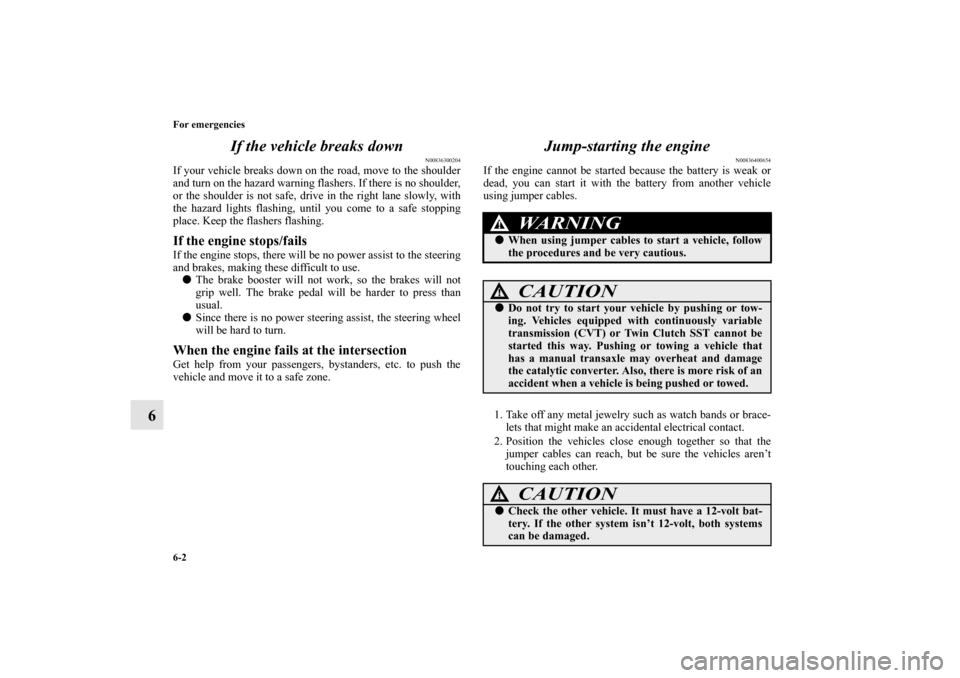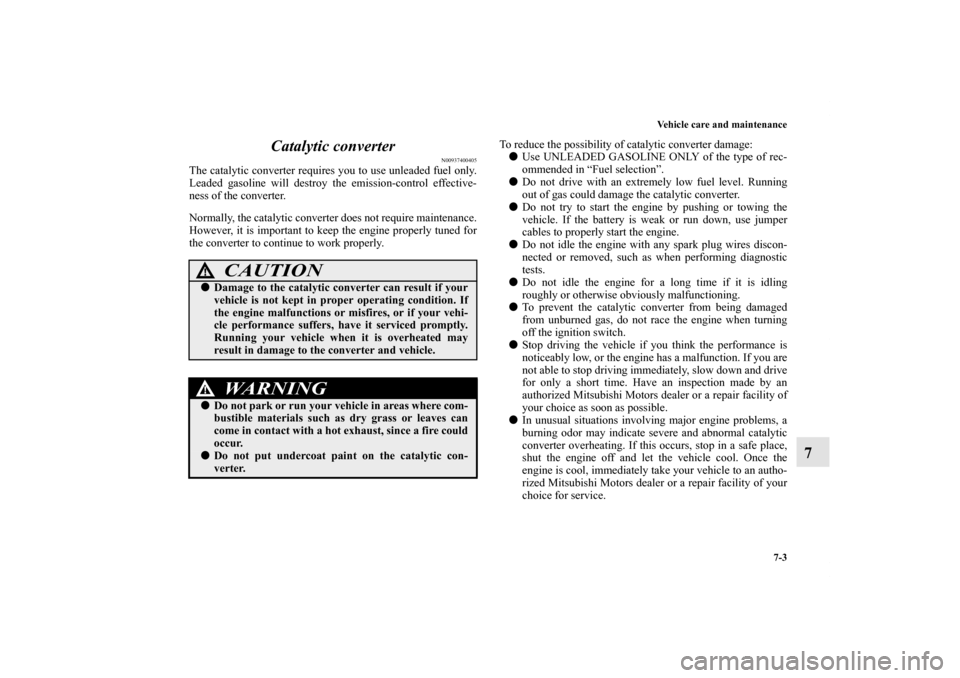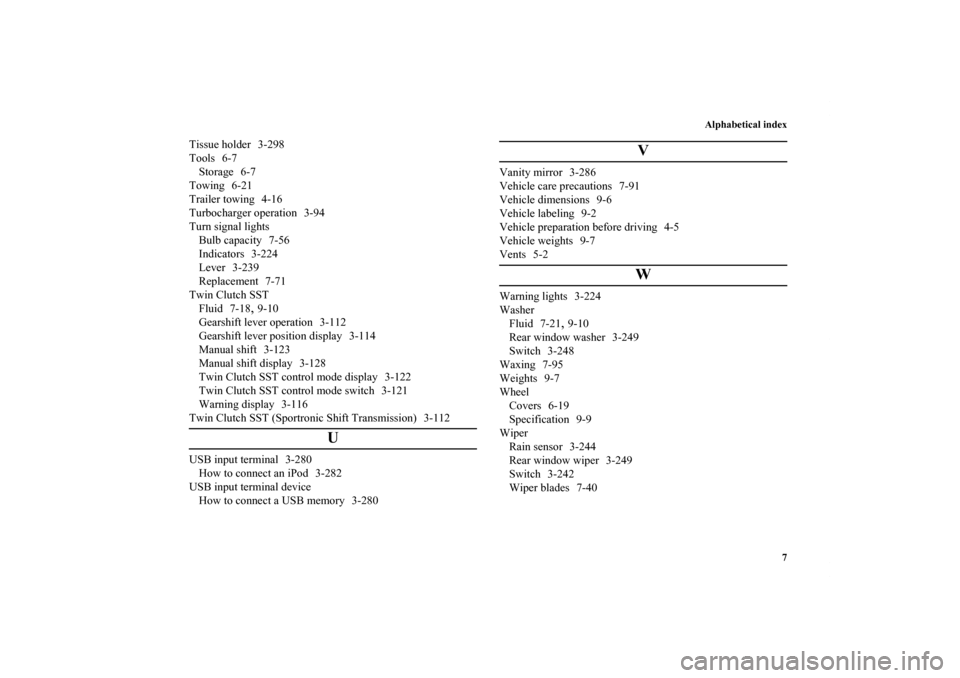Page 558 of 706
6
For emergencies
If the vehicle breaks down . . . . . . . . . . . . . . . . . . .6- 2
Jump-starting the engine . . . . . . . . . . . . . . . . . . . .6- 2
Engine overheating . . . . . . . . . . . . . . . . . . . . . . . .6- 5
Tools and jack . . . . . . . . . . . . . . . . . . . . . . . . . . . .6- 7
How to change a tire . . . . . . . . . . . . . . . . . . . . . . .6- 8
Towing . . . . . . . . . . . . . . . . . . . . . . . . . . . . . . . . . .6- 21
Operation under adverse driving conditions . . . . .6- 23
BK0151000US.book 1 ページ 2012年3月29日 木曜日 午後6時8分
Page 559 of 706

6-2 For emergencies
6If the vehicle breaks down
N00836300204
If your vehicle breaks down on the road, move to the shoulder
and turn on the hazard warning flashers. If there is no shoulder,
or the shoulder is not safe, drive in the right lane slowly, with
the hazard lights flashing, until you come to a safe stopping
place. Keep the flashers flashing. If the engine stops/fails If the engine stops, there will be no power assist to the steering
and brakes, making these difficult to use.
�The brake booster will not work, so the brakes will not
grip well. The brake pedal will be harder to press than
usual.
�Since there is no power steering assist, the steering wheel
will be hard to turn. When the engine fails at the intersection Get help from your passengers, bystanders, etc. to push the
vehicle and move it to a safe zone.
Jump-starting the engine
N00836400654
If the engine cannot be started because the battery is weak or
dead, you can start it with the battery from another vehicle
using jumper cables.
1. Take off any metal jewelry such as watch bands or brace-
lets that might make an accidental electrical contact.
2. Position the vehicles close enough together so that the
jumper cables can reach, but be sure the vehicles aren’t
touching each other.
WA R N I N G
!�When using jumper cables to start a vehicle, follow
the procedures and be very cautious.
CAUTION
!�Do not try to start your vehicle by pushing or tow-
ing. Vehicles equipped with continuously variable
transmission (CVT) or Twin Clutch SST cannot be
started this way. Pushing or towing a vehicle that
has a manual transaxle may overheat and damage
the catalytic converter. Also, there is more risk of an
accident when a vehicle is being pushed or towed.
CAUTION
!�Check the other vehicle. It must have a 12-volt bat-
tery. If the other system isn’t 12-volt, both systems
can be damaged.
BK0151000US.book 2 ページ 2012年3月29日 木曜日 午後6時8分
Page 578 of 706
For emergencies
6-21
6 To w i n g
N00837000833
If your vehicle needs to be towedIf towing is necessary, we recommend you to have it done by a
commercial tow truck service.
When towing is required, transport the vehicle using a tow
truck.
Incorrect towing equipment could damage your vehicle.NOTE�Your vehicle cannot tow any other vehicle.
There may be local regulations concerning towing in your area.
Obey the regulations of the area where you are driving your
vehicle.
CAUTION
!�Do not attempt to be towed by another vehicle with
a rope.
Do not tow all-wheel drive vehicles with this style. Type A
Type B
Type C
Type D
Type EDo not tow continuously variable transmission
(CVT) vehicles or all-wheel drive vehicles with this
style.
BK0151000US.book 21 ページ 2012年3月29日 木曜日 午後6時8分
Page 579 of 706

6-22 For emergencies
6
Towing the vehicle by a tow truck
Towing manual transaxle vehicles with rear wheels off
the ground (Type B)Place the gearshift lever in the “Neutral” position.
Turn the ignition switch to the “ACC” position and secure the
steering wheel in a straight-ahead position with a rope or tie-
down strap. Never place the ignition switch in the “LOCK”
position when towing.Towing with front wheels off the ground (Type C)Release the parking brake.
Place the gearshift lever in the “Neutral” position (manual tran-
saxle) or the selector lever in the “N” (NEUTRAL) position
(CVT).
CAUTION
!�This vehicle must not be towed by a tow truck using
sling lift type equipment (Type A) as illustrated.
Using a sling lift will damage the bumper and front
end.�Do not tow all-wheel drive vehicles with the front or
rear wheels on the ground (Type B or Type C) as
illustrated. This could result in the driving system
damage or vehicle may jump at the carriage.
If you tow all-wheel drive vehicles, use Type D or
Type E equipment.�Do not tow continuously variable transmission
(CVT) vehicles with the driving wheels on the
ground (Type B) as illustrated. If the vehicle is
towed like this, the continuously variable transmis-
sion (CVT) fluid may not reach all parts of the
transmission, thus damaging it.
If you tow CVT vehicles, use Type C, D or E equip-
ment.�If the manual transaxle is malfunctioning or dam-
aged, transport the vehicle with the driving wheels
on a carriage (Type C, D or E) as illustrated.
�[For front-wheel drive vehicle equipped with the
active stability control (ASC)]
If the vehicle is towed with the ignition switch in the
“ON” position and only the front wheels or only the
rear wheels raised off the ground, the ASC may
operate, resulting in an accident. When towing the
vehicle with only the front wheels or only the rear
wheels raised, keep the ignition switch in the
“LOCK” or “ACC” position.
WA R N I N G
!�To prevent entry of exhaust gas from the towing
vehicle, set the selection switch to the recirculation
position.
CAUTION
!
BK0151000US.book 22 ページ 2012年3月29日 木曜日 午後6時8分
Page 584 of 706

Vehicle care and maintenance
7-3
7 Catalytic converter
N00937400405
The catalytic converter requires you to use unleaded fuel only.
Leaded gasoline will destroy the emission-control effective-
ness of the converter.
Normally, the catalytic converter does not require maintenance.
However, it is important to keep the engine properly tuned for
the converter to continue to work properly. To reduce the possibility of catalytic converter damage:
�Use UNLEADED GASOLINE ONLY of the type of rec-
ommended in “Fuel selection”.
�Do not drive with an extremely low fuel level. Running
out of gas could damage the catalytic converter.
�Do not try to start the engine by pushing or towing the
vehicle. If the battery is weak or run down, use jumper
cables to properly start the engine.
�Do not idle the engine with any spark plug wires discon-
nected or removed, such as when performing diagnostic
tests.
�Do not idle the engine for a long time if it is idling
roughly or otherwise obviously malfunctioning.
�To prevent the catalytic converter from being damaged
from unburned gas, do not race the engine when turning
off the ignition switch.
�Stop driving the vehicle if you think the performance is
noticeably low, or the engine has a malfunction. If you are
not able to stop driving immediately, slow down and drive
for only a short time. Have an inspection made by an
authorized Mitsubishi Motors dealer or a repair facility of
your choice as soon as possible.
�In unusual situations involving major engine problems, a
burning odor may indicate severe and abnormal catalytic
converter overheating. If this occurs, stop in a safe place,
shut the engine off and let the vehicle cool. Once the
engine is cool, immediately take your vehicle to an autho-
rized Mitsubishi Motors dealer or a repair facility of your
choice for service.
CAUTION
!�Damage to the catalytic converter can result if your
vehicle is not kept in proper operating condition. If
the engine malfunctions or misfires, or if your vehi-
cle performance suffers, have it serviced promptly.
Running your vehicle when it is overheated may
result in damage to the converter and vehicle.
WA R N I N G
!�Do not park or run your vehicle in areas where com-
bustible materials such as dry grass or leaves can
come in contact with a hot exhaust, since a fire could
occur.�Do not put undercoat paint on the catalytic con-
verter.
BK0151000US.book 3 ページ 2012年3月29日 木曜日 午後6時8分
Page 704 of 706

Alphabetical index
7
Tissue holder 3-298
Tools 6-7
Storage 6-7
Towing 6-21
Trailer towing 4-16
Turbocharger operation 3-94
Turn signal lights
Bulb capacity 7-56
Indicators 3-224
Lever 3-239
Replacement 7-71
Twin Clutch SST
Fluid 7-18
,9-10
Gearshift lever operation 3-112
Gearshift lever position display 3-114
Manual shift 3-123
Manual shift display 3-128
Twin Clutch SST control mode display 3-122
Twin Clutch SST control mode switch 3-121
Warning display 3-116
Twin Clutch SST (Sportronic Shift Transmission) 3-112
U
USB input terminal 3-280
How to connect an iPod 3-282
USB input terminal device
How to connect a USB memory 3-280
V
Vanity mirror 3-286
Vehicle care precautions 7-91
Vehicle dimensions 9-6
Vehicle labeling 9-2
Vehicle preparation before driving 4-5
Vehicle weights 9-7
Vents 5-2
W
Warning lights 3-224
Washer
Fluid 7-21
,9-10
Rear window washer 3-249
Switch 3-248
Waxing 7-95
Weights 9-7
Wheel
Covers 6-19
Specification 9-9
Wiper
Rain sensor 3-244
Rear window wiper 3-249
Switch 3-242
Wiper blades 7-40
BK0151000US.book 7 ページ 2012年3月29日 木曜日 午後6時8分